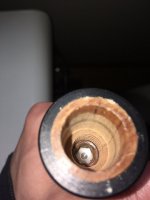I don't see any signs of epoxy but it could have been put into the hole before the bolt. But that rust could for sure be the problem. I'd be careful with WD-40 or PB Blaster or any liquids as it will make the wood swell which could add to the problem.
If it were my cue I'd try an impact wrench with the air dialed down a bunch. This is a two man job, one on the impact wrench and one holding the cue. Govern the aggressiveness by how much pressure you hold the cue with your hands. Then you can increase the aggressiveness by either increasing the air pressure or not letting it slip in your grip as much. Sometimes the hammering motion will break it loose much better than constant pressure. Just be sure to start out slow and work up, you'll be able to see any problems developing early that way.
Be sure to keep good pressure in the hex bit, you don't want to round it out.
Only after trying this would I resort to some kind of anti rust liquid and then hit it again with the impact wrench. Where there's a will there's a way.
This is all assuming that there's no epoxy in there, if there is and you hit it hard enough you will still get it out but the threads will probably come with it! Then it would need to be drilled/bored and retapped larger if you wanted to add adjustable weight in the future.
Just thought I'd add.... I would only do this to my own cue (if I absolutely couldn't live with the weight) or a crap cue. I would never attempt this on any decent cue, but then again I'd probably never have to.


